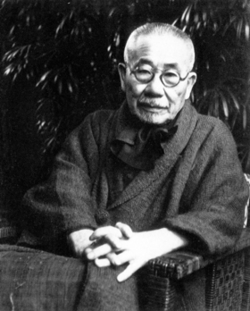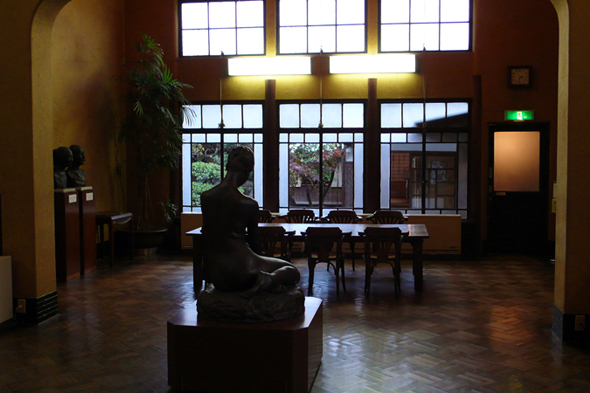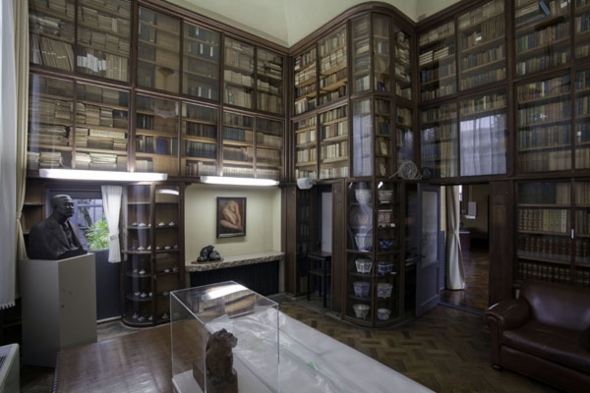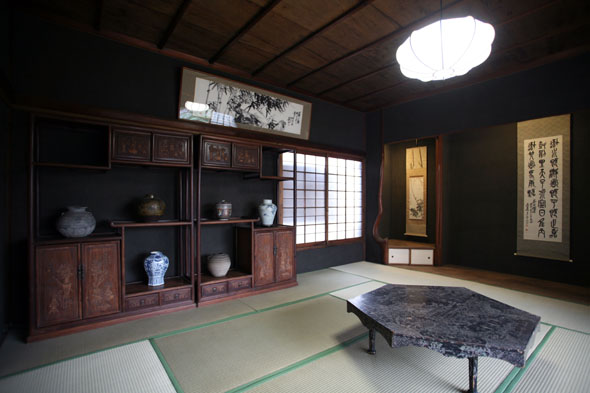
Fumio Asakura (1883-1964)
Fumio Asakura was born the fifth of 11 children in Oita Prefecture, and was adopted into the Asakura family when he was10 years old. He went to Tokyo, following his blood brother, Osao Watanabe who was active as a sculptor, in 1902, and was enrolled at the Department of Sculpture, Tokyo Fine Arts School (present Tokyo University of the Arts). His sculpture, "Statue of Vice Admiral Kagenori Nire," one of three bronze statues of vice admirals that the Naval Department invited from the public, won the first prize while he was in the school, and he stood out as a budding sculptor. After entering the graduate course, he set up his studio at Tennoji-cho, and taught younger students. He created "Grave Keeper" in 1910, and was selected as the youngest judge at the 10th Bunten exhibition, establishing himself as a sculptor. He had created many sculptures, including "Statue of Shigenobu Okuma," "Statue of Rentaro Taki" and "Futabayama-zeki." (The photograph is taken from "Asakura Choso-kan," a pictorial book.)
Artistic designs are applied to details of house.
Glass doors with iron frames are fitted between log pillars, which open into the studio's garden. The lower part of the studio's entrance is covered with split bamboos, and polished logs are used for staircase railings and pillars. In this way, although the house is a three-story concrete building and its exterior walls are black, the warmth of wood can be felt in the rooms. As Fumio Asakura himself said that he intended to design the interior that was hard to imagine that it was inside the reinforced concrete house, those wood and bamboos create a warm feeling as if these materials compensate for the reinforced concrete structure that was adopted in order to install an elevating machine in the studio. Such ingenuity is applied to every portion of the rooms. Bamboo lattices are used for the transom window of the studio wing's entrance, and bamboos that are curved along a curved surface of walls is set up at an alcove located on the left side of the entrance. Bamboos are also put on a wainscot of the hall leading to the entrance, and naturally-curved logs are used for a staircase that leads up to the second floor. The staircase's risers are also covered with bamboos. Such a design with bamboos and logs is applied to various portions of the museum's rooms.

Studio
Although iron window frames are used for windows facing the garden, wood pillars that stand on both sides of the window frames, parquet and walls finished with floss silk create a soft atmosphere in the room. It is said that the reason edges of walls and partitions in the studio are curved is to eliminate unnecessary vertical lines on the background when he looks at sculptures. Sunlight comes into the studio from north and south windows and a window facing the courtyard.

Study
Bookshelves are placed on the three sides of the room, and many books are lined up on them. Since the original lighting apparatus was left in the study, a new lighting apparatus in the studio was also restored, imitating the original one.

"Soshin-no Ma," or room of straightforward mind
"Soshin" means a mind without lies or pretension. Among elaborately designed rooms, Soshin-no Ma particularly produces a composed atmosphere.

Fumio Asakura (1883-1964)
Fumio Asakura was born the fifth of 11 children in Oita Prefecture, and was adopted into the Asakura family when he was10 years old. He went to Tokyo, following his blood brother, Osao Watanabe who was active as a sculptor, in 1902, and was enrolled at the Department of Sculpture, Tokyo Fine Arts School (present Tokyo University of the Arts). His sculpture, "Statue of Vice Admiral Kagenori Nire," one of three bronze statues of vice admirals that the Naval Department invited from the public, won the first prize while he was in the school, and he stood out as a budding sculptor. After entering the graduate course, he set up his studio at Tennoji-cho, and taught younger students. He created "Grave Keeper" in 1910, and was selected as the youngest judge at the 10th Bunten exhibition, establishing himself as a sculptor. He had created many sculptures, including "Statue of Shigenobu Okuma," "Statue of Rentaro Taki" and "Futabayama-zeki." (The photograph is taken from "Asakura Choso-kan," a pictorial book.)













